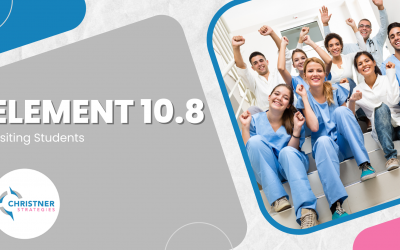LCME Element 10.9 – Student Assignment
A medical school assumes ultimate responsibility for the selection and assignment of medical students to each location and/or parallel curriculum (i.e., track) and identifies the administrative office that fulfills this responsibility. A process exists whereby a medical student with an appropriate rationale can request an alternative assignment when circumstances allow for it.
Hidden Curriculum
Medical schools have increasingly developed geographically distributed campuses and parallel curricula. These curricular dimensions enrich a program but also require thoughtful planning and communication. If a school offers both parallel tracks and regional campuses, then it must explain the process for each in the DCI and to site visitors. In short, a program must describe the why, what, how, who, and when of these processes.
Why? Provide the background and purpose of the parallel curricula or regional campuses, such as growing the pipeline for primary care physicians, increasing clinical capacity, or ensuring sufficiency of patient care experiences.
What? Specify the portion of the curriculum that the track or campus assignment encompasses, such as preclinical, core clinical, elective, or all four years.
How? Explain how the program makes admission/assignment decisions, such as criteria, rankings, or algorithms. From a student perspective, be prepared to explain how they learn about the tracks/campuses, decision-making/assignment process, mechanism for requesting an alternative assignment, and option to swap assignments with peers.
Who? Identify who is responsible for orchestrating the processes, making final determinations, and reviewing requests for alternative assignments. If there is a committee responsible for these decisions, then explain its composition.
When? Describe the timing of communication to students about tracks/campuses, as well as when assignments are released to them (e.g., during the admission process or preclinical portion). Take into consideration the timing of potential relocations if your curriculum does not follow a typical academic year since there are housing and health insurance implications.
Best Practices
Like so many elements, it is a best practice to establish and circulate a policy detailing the student assignment process as well as a campus change policy that explains how students can make a request for an alternative assignment. Even with policies in place, a school should commit to transparency on how they make decisions on parallel track admissions and campus assignments, it should commit to transparency. Leadership should be up front about the process, chances of receiving top choices, and factors that inform decision-making, including the minimum qualifications and use of algorithms.
Admission to a parallel track or relocation to a new city is a significant decision for students. As such, ensure that you have a communication strategy that repeats key information in different formats about the options, processes, and policies (e.g., websites, emails, class meetings). The communication should ideally begin early during the admission and interview processes for medical school. One of the best ways to assist students in their decision-making is to facilitate conversations with students who have participated in a program/campus. Depending on the timing, a program should build time into the preclinical curriculum to allow exploration of programs, locations and communities.
Along these same lines, ensure that faculty and staff from all locations are aligned in their messaging to students. A school wants to highlight the unique natures of its regional campuses while minimizing the potential for competition. For this reason, central leadership must take the lead in imparting to students the measures it takes to maintain educational comparability.
Continuous Quality Improvement
It is helpful to track and review metrics for a campus assignment process, including the percentage of students receiving first, second, or third choices as well as number and nature of change requests. Internal surveys should be aligned with the GQ to capture feedback from students about their experiences at regional campuses, and the internal survey may opt to solicit feedback on the assignment process itself (clarity of policies, transparency in decision-making, and ability to make an informed decision).



0 Comments